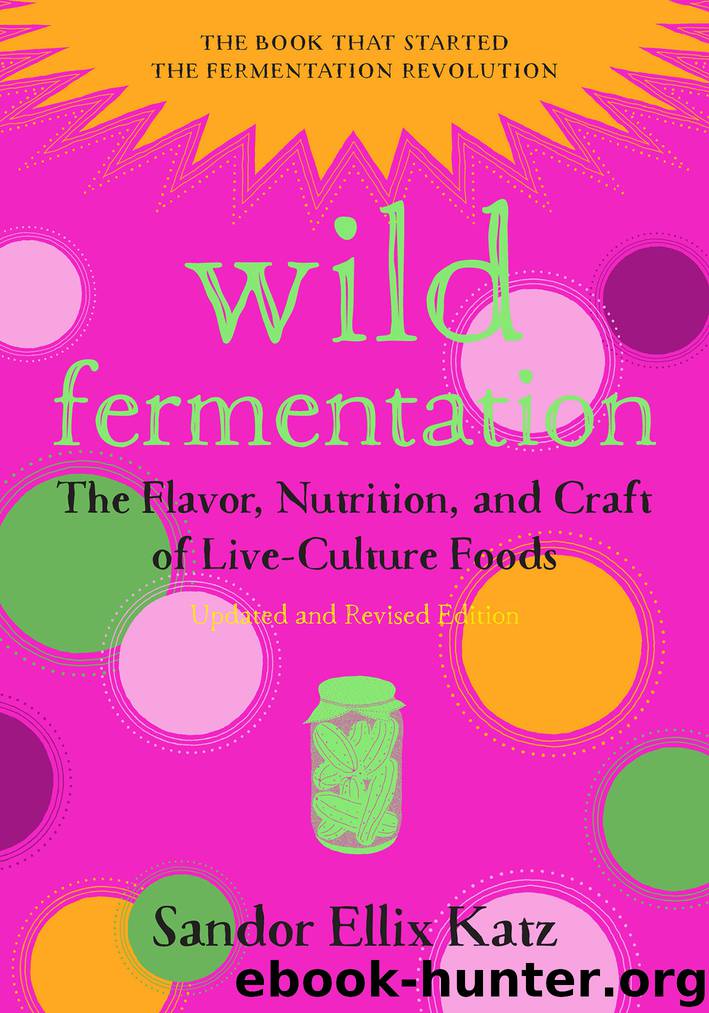Wild Fermentation by Sandor Ellix Katz

Author:Sandor Ellix Katz
Language: eng
Format: epub
Publisher: Chelsea Green Publishing
Published: 2016-08-26T04:00:00+00:00
8: grain ferments
(Porridges, Soft Drinks, Soups, Flatbreads, and Breads)
The objective of grain fermentation is fundamentally different than with the fermentation of vegetables or milk, in which preservation is foremost. Grains (and legumes, covered in the next chapter) preserve best in their mature dried state, maintained in a cool, dry, and dark environment. It is their dryness that preserves them, for though they—like all the things that make up our food—are populated by elaborate communities of bacteria and yeast, these microbes remain dormant so long as they are deprived of water.
The same dense, dry quality that makes grains so stable for storage also makes them difficult to digest. They nourish us best with the pre-digestion of fermentation. Seeds have various biological strategies to fend off hungry critters (including us) that can be described as anti-nutrients—for instance, phytates and trypsin inhibitors, which prevent us from accessing nutrients within the seeds. These anti-nutrients are broken down by fermentation, improving the bioavailability of minerals and rendering the grains or legumes more nutritious and more digestible. Fermentation also makes grains and legumes more flavorful and contributes aeration and textural lightness.
There are many ways of fermenting grains. In Western culture, many think first of bread, synonymous with sustenance and representing much more than mere food. The elaborate process of growing and harvesting grain and making bread “symbolized civilization’s mastery over nature,” writes Michael Pollan in The Botany of Desire.1 Bread, or the lack thereof, has inspired revolutions; a rise in the price of bread was one of the sparks that ignited the French Revolution, for example. Bread is a staple food in many parts of the world. It is made in an extraordinary variety of styles, not all of them formed into loaves and baked.
There are many varied flatbreads, of course, cooked from doughs pressed or batters spread, and they are frequently first fermented. You can mill grains into flour (or more coarsely, such as bulgur, polenta, grits, or rolled oats), mix with water, and ferment that. Or you can soak whole grains, then grind them into a dough or batter, and ferment that. You can sprout the grains, first. You can make steam-breads, frybreads, or crackers, or fermented grain-based porridges, soups, and beverages, among them beers (covered in chapter 11). The range of what grains mixed with water can become is nearly infinite, thanks to diverse grains and diverse traditional methods, all facilitated by the rich indigenous microbiota found on all grains, dormant until awakened by water.
Download
This site does not store any files on its server. We only index and link to content provided by other sites. Please contact the content providers to delete copyright contents if any and email us, we'll remove relevant links or contents immediately.
My Pantry by Alice Waters(2546)
The Culinary Herbal by Susan Belsinger(2431)
Food and Water in an Emergency by Food & Water In An Emergency(2342)
Asian Pickles: China by Karen Solomon(2097)
Project Smoke by Steven Raichlen(1999)
Food Storage for Self-Sufficiency and Survival by Angela Paskett(1988)
Smoke & Spice by Cheryl Alters Jamison(1884)
The Jam and Marmalade Bible by Jan Hedh(1619)
Pure Charcuterie: The Craft & Poetry of Curing Meat at Home by Meredith Leigh(1612)
Fermented Vegetables by Kirsten K. Shockey(1523)
Asimov's Science Fiction 020111 by Dell Magazines(1519)
Economic Food Storage Strategies for Disaster Survival: Start Today and Have Enough Food Your Family Will Eat to Survive Any Disaster Without Going Broke by Sandy Gee(1506)
Asian Pickles by Karen Solomon(1455)
Canning for a New Generation by Liana Krissoff(1418)
The Ideal Pantry: Your Comprehensive Guide to Food Remedies and Preservation Techniques by Ben Night(1417)
The Healthy Meal Prep Cookbook: Easy and Wholesome Meals to Cook, Prep, Grab, and Go by Amidor RD CDN Toby(1397)
Not Just Jam: The Fat Pig Farm book of preserves, pickles and sauces by Evans Matthew(1372)
The Complete Guide to Drying Foods at Home: Everything You Need to Know About Preparing, Storing, and Consuming Dried Foods by Paajanen Terri(1317)
Jams, Preserves and Chutneys by Marguerite Patten(1308)
